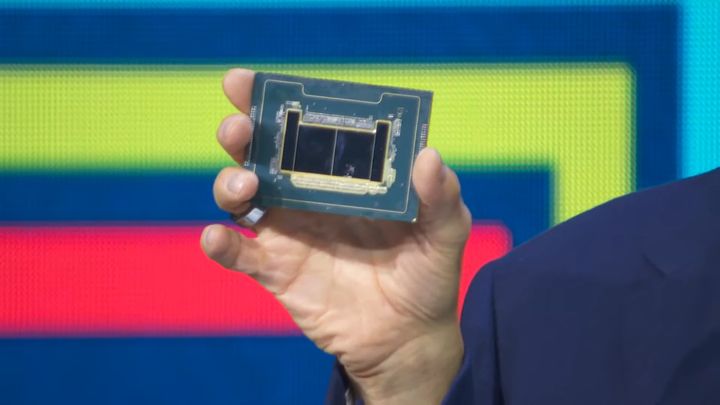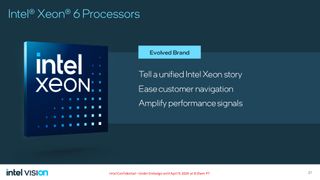Intel unveils new Xeon 6 branding for Granite Rapids and Sierra Forest processors — efficiency core models launch this quarter; performance-core models come soon after
New branding amplifies performance signals...or something.

Intel announced at its Vision 2024 event that the next-gen Granite Rapids and Sierra Forest processors will be branded ‘Xeon 6,’ thus dispatching with its old nomenclature that used generational designators, like the preceding ‘Fifth-Gen Xeon Scalable’ models. This new branding somewhat mirrors Intel's new simplified branding for its consumer chips, which it announced last year. Intel also provided an update on the launch schedule, indicating the Sierra Forest and Granite Rapids chips remain on track. The company also briefly mentioned new software support for the MXFP4 data format, which the company says allows the CPUs to run 70 billion parameter Llama-2 models and reduce next-token latency by up to 6.5x compared to fourth-gen Xeon.

Intel’s existing 'Emerald Rapids' Fifth-Gen Xeon models won’t see a rebrand, so the new branding nomenclature will apply only to Xeon 6 and newer processors. The company says the new branding makes it “easier to tell a unified Intel Xeon story, eases customer navigation with intuitive organization, and amplifies the performance signals.”


As you can see in this table that outlines the current-gen Xeon product stack, Intel’s branding can be more than a little confusing. Intel says this new branding will be simpler and easier to understand, and it will discard some of the sub-brands, though the company didn’t provide further details.
Intel’s current product stack has 32 models divided into six primary swim lanes (second slide). These include processors designed for the cloud, networking, storage, long-life use, single-socket models, and processors designed specifically for liquid-cooled systems. The stack is also carved into Platinum, Gold, Silver, and Bronze sub-tiers.
It isn’t yet clear how Intel will arrange the Xeon 6 lineup to reduce confusion, but with plans to launch Sierra Forest this quarter, we expect to learn more details soon.


Intel says its Xeon 6 Sierra Forest processors, the company’s first data center chips to have an architecture comprised entirely of efficiency cores (E-cores), will arrive as scheduled this quarter. To that effect, Supermicro also announced the early availability of Sierra Forest chips in its Early Ship program and free remote access for testing and validation through its JumpStart program.
Intel has already detailed both its Sierra Forest and Granite Rapids processors. The Sierra Forest chips have an E-core-based architecture designed to deliver the ultimate threaded heft for scale-out, cloud-native, and containerized environments. You can read the deep-dive architectural details here. The chips employ CPU chiplets with the Intel 3 process combined with twin I/O chiplets based on the Intel 7 node to provide a flexible architecture that can scale to higher core counts by adding more chiplets.
Stay On the Cutting Edge: Get the Tom's Hardware Newsletter
Get Tom's Hardware's best news and in-depth reviews, straight to your inbox.
As before, Intel claims Sierra Forest delivers a 2.4X improvement in performance per watt and a 2.7X improvement in performance per rack. Intel also claims that 72 Sierra Forest server racks will provide the same amount of performance as 200 server racks equipped with the aging second-gen Xeon models, thus saving a megawatt of power. The company has also announced a 288-core Sierra Forest model that will arrive later this year.
Intel's Granite Rapids processors slot in for general-purpose workloads and feature a more standard performance-core (P-core) based design. Intel's press release mentions that the processors now support the MXFP4 data format, a new narrow-precision format that's championed by OCP with broad support from other vendors, like Nvidia, AMD, and Arm, among many others.
Intel says MXFP4 software support enables Granite Rapids to reduce next token latency by up to 6.5x over its older fourth-gen Xeon using FP16, and that it allows the CPU to run a 70 billion parameter Llama-2 model. Intel hasn't shared any more detail about this caveat beyond a bullet point on the press release, but we'll be sure to follow up as more details emerge.
Intel says the Granite Rapids processors will follow ‘soon after’ Sierra Forest but hasn’t committed to delivering them in a specific quarter.

Paul Alcorn is the Managing Editor: News and Emerging Tech for Tom's Hardware US. He also writes news and reviews on CPUs, storage, and enterprise hardware.
-
CmdrShepard Intel branding is as confused and lost as a child in a candy shop.Reply
They should be ridiculed for it every step of the way by the press. -
Thanks for the article.Reply
Can you make some corrections though, since there has been some confusion/typos regarding the naming scheme which Intel uses vs AMD.
Granite Ridge has been used instead of "Granite Rapids" at some parts (not all), including the sub-title/heading and few paragraphs.
We all know that Granite Ridge is the "rumored" codename for the desktop implementation of the "Zen 5" micro-architecture, the upcoming Ryzen 9000 series, so it's obviously confusing.
Even I get confused when it comes to "Granite Ridge", and "Granite Rapids" naming scheme. :rolleyes:
Intel announced at its Vision 2024 event that the next-gen Granite Ridge and Sierra Forest processors will be branded ‘Xeon 6,’ thus dispatching with its old nomenclature that used generational designators,
Intel also provided an update on the launch schedule, indicating the Sierra Forest and Granite Ridge chips remain on track.
Intel has already detailed both its Sierra Forest and Granite Ridge processors.
Most Popular



